1965 super punch 17 problem
Hi all,
I am currently stuck with my suffolk super punch,
Having had it running for the first time yesterday, i noticed the front drive shaft spinning without the hand clutch engaged. Engaged hand clutch and blades began to spin quickly. Switched, disengaged hand clutch and the shaft span again when started again.
I have removed the circlip and moved the hand clutch down the shaft, loosened the 4 engine mounting bolts and slid the engine away from the shaft to allow me to remove the bigger clutch housing and gave it all a rub down with p40 sand paper i.e inside the drum of bigger clutch bell housing, clutch shoes as they needed it and adjusted the clutch shoe adjustment screws so to ensure the clutch was not catching on tick over.
Cleaned the bronze center bearing on the clutch bell housing ( bigger clutch part) and the shaft area where this sits upon and back together again... continues to be the same.. start up hand clutch not engaged... shaft spins. Can confirm the clutch shoes are not grabbing.
Is there supposed to be a bearing in the center of the bigger clutch bell or something? Cant quite understand whats causing it really? Any help is hugely appreciated!
Thanks
Rob
Forums
Thank you for taking the time
Thank you for taking the time to respond, this is hugely appreciated.
I do believe it is the cast iron type. It also has the bigger 2 clutch shoes with the small screws on both shoes to adjust the tension.
Okay... going from what your response, i'm sure the engine is aligned correctly as i also thought of this at the time and spend ages turning the shaft by hand for the lightest drag on the first shaft and secured the engine bolts and it remains at its lightest drag on the shaft so believe its aligned as best as possible.
While the clutch shoes were accessible i did take a look inside where the front shaft locates and did notice what appeared to be a tiny bearing. I did push a small enough flat blade into the center of the bearing and tried to move it and it didnt move.
Is it possible to remove the clutch shoes and access this bearing?. I'm hoping a good soak in plus gas over night and a good dressing in grease will do the trick. Failing that.. is this bearing easy enough to replace? I ask as i'm not sure where to buy it as i cant find it anywhere on the net. (Just done a quick search).
Also... the chains have been checked, they appear okay however... what is the required tension as they all appears sloppy. I.e over 10mm of deflection. I noticed there is a slider that looks like a chain guide however this doesnt appear to tension the chain enough so could kindly advise of how to tension the chain if it sounds like it needs its?.
I have also noticed it has grease nipples on the sprocket end of the front shaft and on the cutting cylinder. Would it be advisable to get the grease gun out and make sure they are grease up?.
Sorry for the millions of questions i have never had a petrol mower.. luckily i know the engines a little bit.
Thanks
Rob
Not sure about your "tiny
Not sure about your "tiny bearing" - the spigot bearing is a cylindrical bush. IF it is necessary to remove it the best line of attack is to remove the back plate from the engine and drive the bush out . Early machines had a "top hat" bush with a flange to take end thrust but the later ones had a plain bush and steel washer - many of which have disappeared over the years!
I've got an early 14" Punch apart at the moment and will take and post some images tomorrow - wet miserable and windy out there now! It's more or less the same construction as your machine. If you can post an image or two it may help in identifying the cause of your problem.
I think i'll take another
I think i'll take another look it tomorrow in the day light and post some pictures of what I find. I'll take the clutch assembly out and remove the back plate and take a look. The back plate.. the spigot, is the spigot bearing the seal/bearing the crankshaft spins on visible from the outside of the engine? If not i'll be taking a further look tomorrow anyway.
The weather sure is horrid tonight.. wet and windy here too in castleford west yorkshire
Thanks
Rob
The clutch back plate is
The clutch back plate is keyed to the crank and rotates as one with it . The top/main drive shaft is supported at its outer end by a ball bearing or self aligning spherical bush and at its inner end in the spigot bearing (bush) in the back plate allowing it to rotate or stand still in relation to the engine..
One thing that I forgot to say is that the clutch drum itself has a bush in it to both support it and allow it to spin freely on the tip shaft when the dog clutch is disengaged . If that bush is worn it will allow the drum to "droop" so that it is no longer concentric with the clutch shoes . If that is the case although the clutch shoes may be contracted enough to clear the drum in a static situation the angular "droop" of the drum may be allowing it to rub on the shoes or the back plate.
Ha ha! Now this is making
Ha ha! Now this is making sense... the bush inside the centrifugal main clutch... isn't a brass arrangement by any chance?. If so i have cleaned this with sandpaper as the inside was all gummed up black. There has also been a slight amount of "play" i.e waggle/wobble when in its correct position i.e fitted over the clutch shoes.. even so when the engine is running. I wondered though... if this bearing/ bush is worn.. and the first shaft is still rotating on idle all the time regardless... how can it be causing it drag and make the shaft spin?.
Explained a bit clearer... engine running dog clutch disengaged =shaft spins at engine speed.
Bush cleaned and has free play on the shaft. My thinking.. free play/clearance.. how is the centrifugal clutch catching or grabbing the shaft.. causing the shaft to rotate?. But as you say in your reply.. it could be catching on the shoes if the clutch drum is "nipping" the shoes. Its easy enough to stop by hand when the clutch shoe grub adjustment screws were adjusted right down i.e allowing very little movement of the shoes while running and also the clutch drum did not become hot ( it did become hot yesterday before i adjusted the clutch shoes.).
So.. if this bearing/bush inside the clutch drum is at fault..
1: does it need greasing? If it continues to rotate the shaft.. how do i replace the bearing/bush?
2: there is a tiny allen bolt on the backside the clutch backplate. I believe this locates the location of the clutch. Could this also be at fault? The clutch back plate sits approximately 1.5 inches from the output seal/bearing on the engine casing?.
Thank you very much for the help and info!.
I did suspect this bush/bearing myself but couldnt think of how it could cause it to rotate the shaft.
Rob
Having re read your post
Having re read your post again, i think i'm getting a clearer picture of what your describing.
Outer end of the top/main shaft, next to the chain casing? It does have a ball bearing fitted inside and has a grease nipple on top of it to allow the bearing to be greased. Is this the correct outer end of the shaft you are talking about?
On the inner end of the shaft there is the clutch drum, inside is the centrifugal clutch shoes and springs and split pins, removing these reveals the pivots the shoes are secured to behind all of this is the clutch back plate which is secured to the shaft with a small black Allen bolt i believe?. I havent removed the clutch shoes as yet and they do appear to move freely enough when slackened off. I did look down the centre of the clutch shoes i.e where the main shaft locates into and even gave that a quick clean up with some sandpaper and also believe where that shaft locates into was bushed/ bearing'd by brass again..
If this is correct.. i believe what you are saying is that there is a bush/bearing in where the clutch back plate locates on to the main bearing?. If so.. remove clutch shoes, remove the Allen bolt that secure the main shaft to the end of the engine crankshaft and pull away the main shaft? Inside the of the main shaft/ top shaft there should be a bearing? Is that correct?
If so.. again where could i find a replacement bearing or.. could be a simple job of clean the end of the crankshaft with some sand paper to remove any rust/crud and same with the bearing/bush and apply grease to the end of the crankshaft and to the bush/bearing inside the back plate?
Thanks
Rob
I will try to take some
I will try to take some images in the morning to illustrate the set up. If any of the bushes have congealed grease inside do not attack them with sandpaper as sanding grit will remain embedded in the bushing material, just clean them out with solvent / petrol on rag, kitchen paper, cotton buds etc. Then just add a drop of oil before assembly - just a drop. . The bushes are made of a " spongey" bronze material that traps oil in their pores so as to supply continuous lubrication without oil being flung around where it is not needed.
Just for information
Clutch drum bush
Clutch drum bush
Clutch back plate bush
Possible area of interference if drum bush is worn and letting the drum sag and rub on back plate
Possible area of interference if the clutch back plate is moved too far away from the engine into the drum and the centre boss of the back plate is forced against the centre of the drum.
Bush dimensions (note: imperial, pre metric) Standard bush available on line from companies such as Simply Bearings or Bearing Boys or your local bearing supplier.
Many thanks for persevering
Many thanks for persevering with me and my troubles,
Thank you for also taking the time to take the photos and your fantastic reply!
Here are my photos from today and the condition of things.
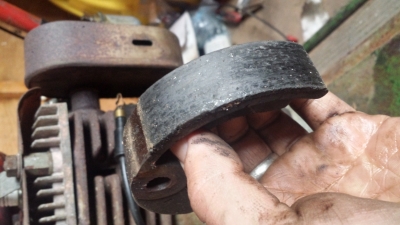
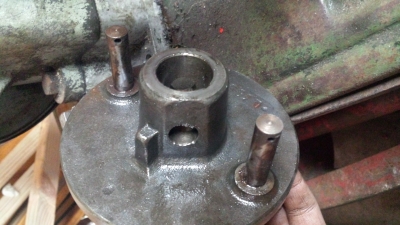
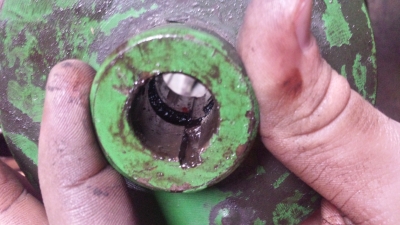
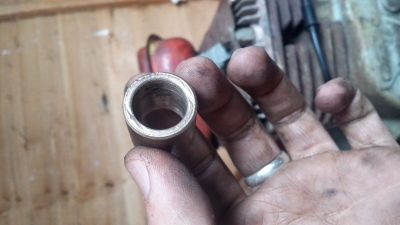
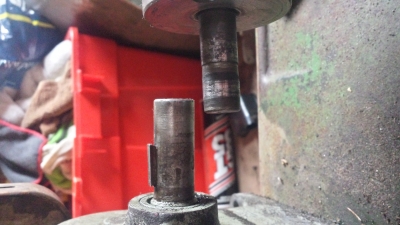
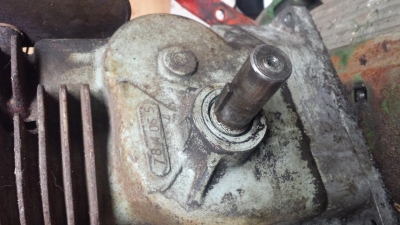
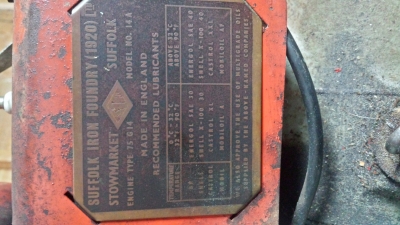
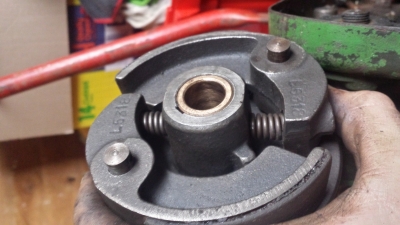
The bush on its own in my
The bush on its own in my hand is the bush from the clutch drum. I have cleaned everything up a tooth brush and petrol and cleaned the end of the crankshaft and first/main shaft with sandpaper and cleaned and grease lightly and also cleaned the bushes and popped them back in and applied a dab of oil as you directed and tge problem continues.
The backplate is secured to the end of the crankshaft wit a small allen bolt. I have moved the backplate to where the drum is on the running edge of the backplate.. there is movement when the clutch drum is fitted in its correct place should the drum actually be able to be wobbled by handi.e by 2+mm of slop?.
When started.. i did still find the shaft still spun on tickover although it did seem easier to stop with my foot and when switching off the clutch drum spun freely and wasnt warm to the touch ( if it was hot or warm this should indicate the shoes grabbing?).
Seems better however... on tickover the shaft still spun without the hand clutch engaged to be clear.
Sudden thought has just occured to me...
End of crank shaft spins.. in turn spinning the clutch backplate ( has to due to the small allen bolt that secures the backplate to the crankshaft).
As the clutch shoes are spinning and are free away from catching/grabbing the drum.. could it be the end of the first/main shaft is inserted too far inside the clutch backplate or the backplate is located too closely to the clutch drum still resulting in the shaft being turned or the drum being caught by the running edge of the backplate or shoes due to wear in the bush/bearing?...
Are these likely and do those bushes look like they could do with being replaced or sound like they need to be replaced?.
A millions thanks for the fantastic help and i'm sure i'll be posting pictures of the grass having been cut with this mower :) with thanks for your help :)
Thanks
Rob
2 mm of end float /
2 mm of end float / longitudinal movement is OK and can be adjusted by the position of the back plate on the engine crank (don't forget the woodruff key which transmits the drive, the allen or square headed bolt just locates the back plate longitudinal)
BUT 2mm of SLOP - up and down movement - is most probably the cause of your problem as I would guess that the rim of the drum ia resting on the rim of the back plate. A new bush in the drum is required to remedy that unless the shaft is badly worn as well!. You may be able to test that theory by sliding the back plate towards the engine so that the rim of the drum is just clear of it. At that point with no clutch shoes fitted there should be no drive regardless of rpm.
it should also be considered that wear in the spigot bush will also allow the top shaft to drop and affect the relationship between the drum and back plate so if you are going to replace one bush why not do both?
For the sake of PC Health and Safety - never run with the clutch shoes in place unless they are enclosed by the drum.
thanks for the info, I will
thanks for the info, I will check and try moving the backplate further towards the engine, just in case that helps the situation.
from your reply and the fact the bushes may never have been replaced since the day it was built and the fact I have cleaned them with sandpaper (not knowing this was causing damage) I have ordered 3 new bushes from bearing boys to the exact dimension you supplied in the picture (very useful! many thanks as I would have struggled with the sizes).
I wont be doing anything until monday now at the earliest due to commitments however.. I'll remove the clutch shoes and position the backplate so the rim is just clear of the drum and see if that makes a difference and await the new bushes to arrive.
I'm also thinking of greasing the two grease points - top shaft bearing outter end and the cutting cylinder grease nipple too. - what type of grease should I use? is the grease nipple a specific size? also... is there any adjustment on the rear roller or the handle that is used to engage drive and disengage drive as it is pretty tight and needs a little bit of a quick and when it is engaged it clunks and jumps forward.
thanks again for all the help, I am learning a great deal already and feel confident the information from yourself is adding to my mechanical knowledge. had no idea these bearings existed (used to working on cars and classic cars).
thanks
rob
Sounds like progress. The
Sounds like progress. The oilite bushes come pre loaded with oil but I quite often double check this by standing a bush on my left thumb, filling it with oil and then pressing my right thumb over it to pressurise it - very satisfying (but messy) to see the oil oozing out of the pores in the bush in little droplets !
Other grease points - medium multi-purpose grease.
The rear roller dog clutch will clunk if it so happens that when you engage it the raised portions on the two halves are opposite each other - as they are turned relative to one another the raise parts of one half will drop into the recesses in the other half. If done under power there will be a noticeable clunk and jerk. Easily avoided by releasing the engagement lever then giving the mower a push forward or pull back to engage the dogs before revving up to engage the drive through the centrifugal clutch
Talking of classic cars; on cars of a certain age it would be usual to find a bush in the centre of the flywheel to support the gearbox first motion shaft after it has passed through the clutch - same but different !!
Regarding the lubrication of
Regarding the lubrication of Oilite bushes an alternative (and cleaner) way is to soak them in some clean oil over night before assembly, might not be quite so satisfying but it avoids the risk of oil running up your arm.
Picking up on a comment made earlier about learning engineering while investigating and fixing the mower you are quite correct, there is much can be learned from delving into the innards of a decent mower.
Thanks for the help and info,
Thanks for the help and info, highly appreciated! Hopefully the oilite bearings/bushes will arrive soon. On another note, is it okay to use sae30 briggs engine oil for the bushes or other? As i will "check" the bearing/bushes when they arrive.
I'll try that method when i get the mower problem sorted and hopefully that harsh "clunk" will be avoided by pushing it forward. Is it fair to assume that by pushing the mower forward to allow the dog gears to engage before applying throttle will lower/avoid unneccesary damage to the dog gears etc?.
Hopefully the bearing/bushes will solve the issues :).
I will update when the bushes/bearing arrive and will have a tinker with the position of the backplate. Also one last question. On reassembly would it be okay to apply a smear of white grease to the inside of the clutch drum ( around the edge of the bearing/bush and a small smear of white grease to the face of the backplate. Just to eliminate this as a possible cause of friction.
I have always liked classic cars since a young age due to my parents owning such. Im 23 and having owned a dolomite 1300 as my first car at 19 along with a few others not quite of the same era.. everything is a learning curve but i enjoy older engines and engineering over electrical engineering. I also like the history that comes with older engineering like this as you know that at one time... somebody will have built this by hand over a machine that built it... plus you can't knock the quality and lifespan!!
Thanks
Rob
Thanks again
Rob
Don't suppose a smear will do
Don't suppose a smear will do any harm but if the back plate is correctly positioned on the crank it shouldn't be necessary. Just make sure that the back plate is flush with the rim of the drum and not pushed any further in. I reassembled my 1952 14" Punch this afternoon and was pleased to note that there was no interference between the drum and back plate without having to change the bushes.
In answer to your question
In answer to your question about oil for the new bushes SAE 30 will be fine for the job but a Multigrade will do the job also. Not so sure about a modern synthetic oil though, that might be going over the top a bit for general lubrication.
Re applying a smear of grease inside the clutch drum I am with wristpin there, it should not be necessary and only increases the risk of it getting where it is not needed. I am sure that with careful assembly, adjustment of the clutch tensioning springs and the correct idling speed you will be successful in your quest.
thanks for the info and well.
thanks for the info and well.. having had some time available today, I removed the old bushes from the clutch drum and backplate and replaced with the new items of the dimensions supplied (thanks wristpin!). I did the trick of filling the bush with oil and applying pressure with thumbs... simple yet clever and somehow strange to witness effectively "sweat" coming from the bush.
anywho... having carefully tapped the new bushes into place and ensuring all mating faces were clean from any debris etc... having carefully aligned the engine... back plate (having an issue here to a degree).. I can confirm.. yes its a huge improvement especially with the clutch drum! not quite as sloppy at all. however... the top shaft still spins and... so does the cutting cylinder. I can report the clutch drum was spinning however was free to be stopped by a single finger (dog clutch not engaged)... but even turning the pullstart just enough to turn the engine over results in the top shaft being turned :(... really up a creek on this one now.
backplate issue im finding is... I can adjust its position on the end of the crank i.e really close to the engine block or... 1 inch away from the engine block but will not get any further away from the engine block due to the hand clutch plate (the plate that is welded to the top shaft)... really have no idea where to go from here in fairness.
how much could I be looking at for a local mower place to take a look at it? or am I better off doing this myself?
Thanks
rob
The edge of the back plate
The edge of the back plate nearest the engine should be flush with the drum and not inset leaving the drum with a mm or two of end float . That will ensure that the back plate boss is not pressing against the inside of the drum.
If, with the dog clutch engaged you can stop the cylinder spinning with one finger on the drum try adjusting the cylinder by one flat of each adjusting nut.
If the cylinder and bottom blade are in good condition they should be just able to cut an inch wide strip of 80gm copy paper at each end and the centre while still not jamming or knocking.
I am inclined to think that
I am inclined to think that you are almost chasing shadows here, if the the clutch and shaft are easily stopped then checking the cylinder adjustment as suggested by wristpin should induce just enough drag into the driveline to bring things to a halt at idle speeds. I would say though that you do need to ensure that the idling speed is as low as possible but still idle reliably.
Hi again :)
Hi again :)
Well.. i have had a good tinker today and with small adjustments to the clutch shoes, drim and the rim of backplate being cleaned and ensuring theres no dinks or high points.. and then further adjusts of the backplate position.. i started it up, and found the top shaft still spun without the dog clutch being engaged... so i set about adjusting the cutting plate thing behind the cylinder just enough to make it stop spinning and yes! We cut half of the grass. Only down side is... its quite loud to say the least.. the noise of the cylinder and cutting plate is the cause but... can't really do anything about that as even 1/8th of a turn on either nut creates just enough drag or too little now.. however... yes it cut the grass and works well however i am worried my neighbours may complain about the noise really. I have got the idle as low as it will go with conking out and also the blade engages at just off idle and take less than quarter throttle to begin moving the rear roller.
Should i be worried about the neighbours so much ? I live in a small culdisac with around 10 hours in the street. Gardens are quite large however my back garden is half the size of a tennis court but my parents house ( same street). Is nearly quarter of an acre. And houses are quite as close.
Thanks
Rob
Just to be sure, you are
Just to be sure, you are talking about the adjustment between the rotating blades and the fixed bottom blade? Probably wrong but I suddenly got the feeling from your wording that you might be adjusting the throw plate (concave/deflector plate) onto the cutting cylinder!
Anyway, if you are doing it correctly and the cylinder blades are clattering it's probably time for the cylinder to be sharpened (restored to concentricity) so that it only just "swishes" past a re-faced bottom blade to achieve a good (and quiet) cut.
You say that the clutch
You say that the clutch starts to engage just above idle speed also that you have adjusted the spring tension on the clutch shoes. I wonder if you now have too little tension on the springs allowing the shoes to engage too early? Try winding the tension on to maximum pressure just to see what happens, from memory you will then need rather more revs to get things moving but you can always ease back the tension to find a middle ground.
Re the noise from the blade if you follow wristpins advice about setting the cut and the blades are in reasonable condition you should be able to set the cut without too much noise.
If you check the blades carefully you may find that the ends of the cylinder blades are striking the leading edge of the bottom blade, if this is only happening at one end of the cylinder the cylinder is possible not going down squarely you can rectify this with more careful adjustment and things may improve, if not you may need to consider a regrind of cylinder and blade.
Just a thought - before attempting any further adjustment of the cylinder check that the cylinder drive chain is not over tight as this will prevent you from adjusting the cylinder correctly.
thanks wristpin and hillsider
thanks wristpin and hillsider
I'm a little unsure of what I adjusted in regards to the concave throw plate and the cutting cylinder and the cutting plate..... I adjusted the two 1/2 inch size nuts just above the cutting cylinder (on the big plate that the engine stands on in either corner. is this for the cutting plate? if so.. how do I adjust the cutting cylinder height?
it is as if the cutting cylinder needs to in light contact with something just to stop that motion.
the clutch shoes have been adjusted many times, I wanted to get it to a point where i wasn't having to use half throttle so the engine noise wouldn't be an issue. the clutch drum begins to spin very slowly just off from idle but at idle the shoes aren't in contact with the drum :).
the confusing point at the moment is the cutting cylinder/cutting plate... should the cutting plate and cutting cylinder be touching enough to stop the top shaft spinning while the engine is ticking over (dog clutch disengaged).
thanks
rob
If the dog clutch next to the
If the dog clutch next to the clutch drum ( don't confuse with the one on the LH end of the rear roller) is disengaged the adjustment of the cutting cylinder makes no difference so all checks should be made with that clutch engaged. Sounds as though you identified the correct adjuster nuts for the cylinder but did you carry out the paper check and are you getting a nice light touch cut all the way along?
Cutting height is a separate issue and is controlled by the Microset adjuster knob that moves the whole front roller assembly up and down. Down for a high cut and up for a lower cut.
just to clear up any
just to clear up any confusion,
I adjusted the cutting cylinder to come into contact with the cutting plate to stop the cutting cylinder rotating when the dog clutch "was not" engaged. However, dog clutch engaged, the cylinder spins and the grass is cut.
the problem I have been having is "start up" - dog clutch not engaged - clutch drum not engaged- top shaft spins, clutch drum remains still and remains cool to the touch - dog clutch spins (not engaged) rest of the top shaft spins - turning the cutting cylinder.
now I have new bushes - cleaned backplate rim and clutch drum - adjusted engine mounting and back plate position.
end result I thought was... "dog clutch disengaged" top shaft spins on idle. to stop this... adjust the cutting cylinder to cause light and even drag across the cutting plate thus stopping the cutting cylinder spinning, stopping the top shaft spinning. (just the end of the crankshaft and backplate spinning only). so I could engage the dog clutch safely and then engage the rear roller knob and it appeared to work however was very noisy - the clatter!
is this how they are supposed to be setup? cutting cylinder in contact with the cutting plate? if so... does it sound like my cylinder and plate need sharpening? again.. if so.. can I do this with an angle grinder with a grinding disc?
I didn't do the paper test today as just getting the cutting cylinder and top shaft to stop turning on idle without the dog clutch engaged took a fair amount of faffing and time and decided to call it a day to not annoy my neighbours
Thanks for persevering!
rob
Just written a lengthy reply
Just written a lengthy reply to your last post but in its wisdom the forum software as seen fit to dump it.
So for now, sharpening a cutting cylinder with an angle grinder is a strict NO NO and could possibly ruin it for ever.
The cutting cylinder and
The cutting cylinder and bottom blade should both have fairly sharp and square edges and as Wristpin said, you cannot resharpen it with an angle grinder, well, not unless you also have a Bernard insitu grinder to go with it ;-)
You need to set the cylinder to bottom blade contact so that they cut thin paper all the way across, without the ends 'rapping', if you cannot do this, perhaps it is time for a re-grind.
If there is little or no load, then the clutch will spin the top shaft, but I have known the plate, that the engine is bolted onto, getting bowed, this puts the clutch slightly out of line and causing the problem you have. You may be able to test this by putting some thin washers under the engine (clutch side) and see if this helps or hinders.
Thank you for the replies,
Thank you for the replies,
I havent had a chance yo do anything today but hoping i will over the next day or so.
Okay i wont grind the cylinder haha!
So the cutting cylinder and cutting plate do need to be in contact at all times
(obviously not over tight against each other i assume).
Thats exactly the issue i have been having.. the top shaft spinning whenever the engine has been running, spinning the cutting cylinder
( even without the dog clutch). So i will give this a go with the paper ( should it shred it ?)
Also if the cylinder needs a regrind... how much could i be looking at it and is it just the cylinder or the cutting plate too?.
I think the engine plate could well be bowed thinking about your comment now... it would explain a few things why it takes some serious adjustments to get the clutch drum to clear the back plate rim ( but there is a clear issue with the overall clearence).
I will try putting washers under the engine and adjust etc and hope this helps further :) certainly am learning a lot and the support and information of this club is fantastic! Hopefully soon i'll be able to post pictures showing a well cut lawn and have the knowledge to keep an already old lawnmower running and healthy for another 50 years! Its already more than double my age :)
Thanks again and i'll update when i have time to have another go.
Rob
I will answer your question
I will answer your question about what to have sharpened by asking you another question.
Would you sharpen only one blade on a pair of scissors ?
Also the paper should cut cleanly, just like if you cut it with a pair of scissors.
From your photos I can see
From your photos I can see that the shaft that passes through the drum and into the carrier bush, where the shoes are, is worn. This could be contributing to your problems. Also your carrier bush is not flanged or 'top hat' to provide a thrust washer in which case you should have a washer there as Wristpin said.
While spending four hours
While spending four hours changing a light bulb in the out door fitting by the workshop door - don't ask - I was giving some thought to your problem.
You have had the benefit of the knowledge of three experienced mower men but, of course, they are working blind and relying on you to apply the donated knowledge and give accurate reports of the state of play. We have touched briefly on tick over rpm and but, understand that you have in fact run the machine without clutch shoes and still have the problem - however have you tried that since renewing the bushes ? The issue of the top hat bush or thrust washer can reasonably be ignored as unless you have pushed the clutch assembly deep into the drum there should be no end thrust as such, A correctly positioned clutch assembly should allow the drum a millimeter or two end float.
Hortimech has raised the possible issue of engine alignment . A valid point but I have to say that I've never experienced it on a cast iron chassis Punch with the machined steel clutch back plate and drum. It was frequently apparent on the later alloy chassis machines with the alloy back plate and pressed steel drum. In fact many of those machines left the factory with shims in place. That said we cannot rule out that for whatever reason your machine may be suffering from misalignment of the engine and drive components so I have taken some snaps to illustrate what to look for.
Looking down from above the machine, is the clutch back plate parallel with the drum? If its flush one side and proud or recessed on the other, slacken the engine fixing bolts a turn or two and twist the lump to correct it.
.
Is the engine vertically aligned with the clutch?
A rule placed vertically across the back plate / clutch assy in a similar fashion to the first image but turned through 90 degrees will show up whether that situation needs attention. If it does, it will require the insertion of a couple of shims on either the starter or the clutch side of the engine depending on which way it is "leaning". One to two millimeter shim thickness should be enough.
and just to show that the four hours were not entirely wasted!
Many thanks for the replies
Many thanks for the replies and i understand hortimech. This is my first petrol lawnmower and not keen on taking the machine to buts to find out how it works without first trying to sort this clear faults. Unsure of whether the cylinder and plate needs sharpening or not.
Thank you fir taking the time to take the pictures and the detailed explination!! This is massively appreciated as what i tried to explain in an earlier post, you have posted a picture of explaining an issue hortimech mentioned earlier. Your last photo and last explination of how the clutch drum should sit correctly around the clutch back plate.
I have noticed there appears to be a larger "gap" between the clutch drum and clutch back plate rim at the bottom of the clutch plate ( small gap at top and bigger gap at the bottom) if i placed a thin shim/washer under the engine crank side this i imagine would iradicate this and make the gap even all round the back plate rim and clutch drum.
( explained this way to hopefully make sense)
Once this little issue is now sorted i do plan on using it a few times to really test things through and then complete a full strip down and rebuild. But knowing these issues are sorted now and how to sort these type of issues will confirm it is a good move to rebuild it when funds and time allow.
Again, many thanks for taking the time to reply and thanks for taking the time for taking the pictures and explenations this is a huge help!
Thanks
Rob
Let's get one thing out of
Let's get one thing out of the way - does it need sharpening? If it will cut paper all the way along without undue pressure between the moving and fixed blade , it's fine. If ti can't, it may still cut grass but will be bruising and tearing and the cut lawn will look " tired" sooner due to the damaged ends going brown sooner.
Now your gap issue. If you consider that the top shaft is suspended between the bearing at the sprocket end and the spigot bush in the clutch back plate the unequal gap that you are observing is possibly due to the clutch end of the shaft dropping due to a worn spigot bush ( no it's new) a worn shaft where it runs in the bush ( maybe , if you have access to a vernier you can check it) or a worn bush in the drum ( no it's new) or the part of the shaft it runs on.
So tilting the engine may solve your "visual" issue but will actually form a ( very small) angle between the spigot bush and the shaft and increase the friction between the two. Exactly what you don't want!
Two suggestions. 1 . Slacken the engine mounting bolts one or two turns and with it running "lean" on and / or twist it within the movement allowed by the slack and see if makes a difference. If the shaft stops turning try to replicate that movement with thin shims.
2. Try running the machine with the clutch shoes ( safety) and drum removed . If the shaft remains stationary it would suggest that the continued rotation may result from the weight of the drum increasing the friction between the shaft and spigot. Not sure what you do about that other than put a mirror finish on the end of the shaft. Also, while the drum is removed it is a good opportunity to observe whether the shaft is entering the spigot " squarely" in all directions.



Assuming that all the chains
Assuming that all the chains are in place and the cutting cylinder correctly adjusted and we take your word that the tick over rpm is correct and the centrifugal clutch shoes are free on their pivots and not dragging on the drum the following needs to be investigated. If you are running the machine partially assembled with no drag on the top shaft it is quite likely that there is enough friction in the spigot to turn the shaft at tickover.
In the centre of the clutch back plate, the bit that carries the shoes, there is an oilite bush or spigot bearing that aligns and supports the top shaft that carries the clutch drum, dog (hand) clutch and extends through the side plate to carry the primary drive sprocket . With the centrifugal clutch disengaged (shoes at rest and not extended) the end of the top shaft should be free to stand still while the back plate is still being driven.
If the shaft is still being driven it follows that there is some interference between the spigot bearing and the shaft causing it to spin.. Likely causes are a dry or failing spigot bearing , misalignment of the engine to the shaft or the back plate being mounted on the crank too far from the engine and pressing inside the drum.
Date wise I'm thinking that your machine will have the machined cast iron back plate and clutch drum. Those components were well made and dimensionally accurate but should your machine have the later pressed steel drum and alloy back plate there were some really wobbly items that could give rise to the sort of problem that you describe.